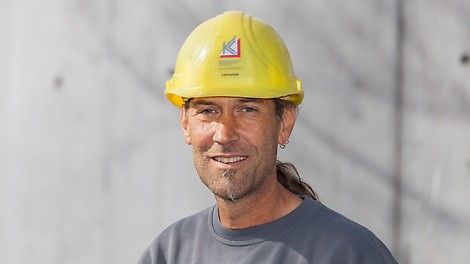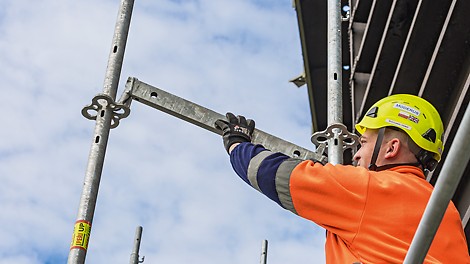
Mr. Czerwinski, please tell us a little bit about yourself.
I am a qualified master builder and do not see myself as a direct contractor, but rather as a service provider. I carry out small-scale projects, mainly for private individuals. In doing so, I always look for something special. I have a burning desire to plan “crazy things”. After the planning phase, I am on site for the entire construction phase of all projects. Like a foreman, as it were. I get involved in everything there, right down to the formwork and concreting.
So you are basically a lone warrior?
I have a squad of four to five people. I also have a draughtswoman for the planning work. On larger projects, I work with a contractor and borrow a few workers from them.
Why did you decide to go it alone?
I learned my trade at a large construction company that unfortunately went bankrupt 20 years ago. After I finished my studies as a master craftsman, I thought: I could do what they are doing just as well, but on a small scale. Because I learned a great deal at the big school.
Actually, the planning work is what I love doing for a living. But variety is the spice of life. Doing the planning work, but also working outdoors. That’s not really possible at a large contractor. So for me, this is the ideal situation.
When you look back on your last few years as a builder, which project fascinated you the most?
That would be my most recent construction sites, the MAC Museum Art & Cars 1 and 2 in Singen and a private architectural concrete villa with a wonderful view of Lake Constance. Those are eye-catching buildings, where the client puts a lot of emphasis on the craftsmanship and you have to be flexible to their wishes.
For example: If the client spontaneously decides they want a slanted wall instead of a straight one, they get a slanted wall. The same applies if they want it to be round. You end up having a wonderful, collaborative working relationship.

MAC Museum Art & Cars, MAC 2
Singen, GermanyThe MAC Museum Art & Cars in Singen has managed to unite automotive and architectural art experiences in two distinctive museum buildings. The new museum building MAC 2 was officially opened in June 2019 after almost 3 years of construction work and boasts around 3,000 m² of additional exhibition space across 5 floors. In MAC 2, sharp edges and rough textures dominate the imposing 26-metre-high building, reminiscent of the shape of rocks.
Project impressions
Customer: Südwestdeutsche Kunststiftung, Singen, Germany
Architect: Daniel Binder, Gottmadingen, Germany
How do you come across these projects?
Basically, I survive on word of mouth. For instance, for my current project, building the architectural concrete villa, the client approached me on a private basis. When I told him I was in the middle of another project, he was willing to push the start of construction back a year. A lot of the time I rely on recommendations. These people appreciate the craftsmanship and the straightforward way of working together.
What exactly makes the collaboration so straightforward?
From a handicraft point of view, these small projects are more interesting. But that doesn’t mean they aren’t complicated sometimes. In my case, there is only one client, one architect and one specialist planner involved. You are actually making all the decisions yourself, without a lot of requests and bureaucracy. This starts with the choice of formwork system. The focus there is on which system can be used to meet the requirements as economically as possible. We can come up with conclusive solutions relatively quickly and gain the full trust of the clients. That’s the great thing about my work.
What is PERI’s role in this?
I always use PERI formwork and scaffolding in my projects. It essentially works like this: After the client has contacted me, I am more or less the facilitator between the client and PERI. I clarify everything with PERI and choose the right systems. However, the costs for this are borne by the client.
Is there a PERI product that you particularly enjoy using?
In the past, for example, it was the TRIO system that was the moneyspinner after it was launched. Recently, I’ve enjoyed working with PERI UP scaffold. That said, the support that the sales engineers provide is also highly valuable. You can count on it being good.
So you attach a lot of importance to on-site cooperation?
Yes. That’s what determines whether formwork is a success or not. If the sales engineer is excellent and knows exactly what is needed on site and is familiar with the systems, this is hugely beneficial. We builders like being convinced by someone like that. Richard Wetzel has been responsible for the Lake Constance region for many years now. He’s old school, a master, a practitioner. You know what you’ve got when you work with people over a number of years.
But it is also important to have skilled workers on the construction site. Unfortunately, however, it is becoming increasingly difficult to find young talent, especially in the crafts sector. Personally, I think that’s a great pity.
Have you always worked with PERI products?
Yes, since my apprenticeship days, actually, so for 30 years now. PERI has very good products and a lot of expertise. Generally speaking, PERI has very simple and ingenious systems that make my work easier. And not only in terms of formwork. PERI scaffolds are also excellent products that can be used in a highly versatile way and increase safety on construction sites.
Speaking of safety, what do you do to make sure that your construction sites are safe?
Safety is a personal concern for me on my construction sites. I see to it myself that, for example, the scaffolding for the projects is planned from the outset and the processes are adapted afterwards – and not the other way round. Sadly, you often see a wall being formed first and the scaffolding being erected afterwards. You often need the scaffolding one way or the other, so to be on the safe side, that’s the first thing I put up on my construction sites.
How does this affect your construction site operations?
Positively. The bottom line is that everyone is happy that they are able to move around the construction site safely. That’s an important part of it.
In your opinion, what are the biggest hazards on the construction site?
I think it depends mainly on the staff on the construction site. Safety always comes first – and you can certainly work much more efficiently as a result. But only if the workers understand this. So the biggest challenge is training the staff and teaching them that safety is a top priority, especially on German construction sites. Sometimes it is not so easy to get workers from all over the world on the same page. I also think that many accidents are caused by the recklessness of construction workers. Deadline pressure plays a major role in that.
Have you ever noticed that your employees’ routines have an impact on their safety?
We certainly have routines in construction – the steps repeat themselves over and over again, after all. A good example is that you get used to heights. If you start at the ground level of a building and move upwards with it, you are more likely to be able to cope with the height and move around more freely on the scaffolding than if you go up a 15-m-high scaffold in one go.
It is therefore all the more important to have confidence in the systems you are using. I have had very good experiences with PERI products on my projects. In my opinion, they always meet the ever-increasing safety requirements in full.
We are on site for you worldwide
Our support knows no borders - no matter where you are in the world. Simply select the website for your country and discover detailed information about our products, projects and contact details for our local contacts. We are always happy to assist you and look forward to helping you too.





